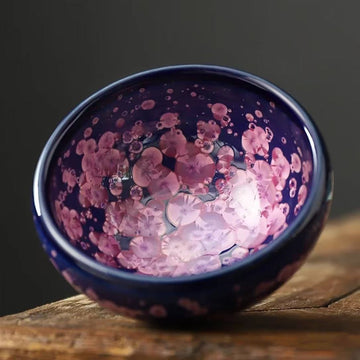From the flickering light of Song dynasty kilns in China to the quiet tearooms of Japan, the Tenmoku tea bowl has traveled across borders, centuries, and philosophies—yet its beauty remains timeless.
But what exactly is a Tenmoku bowl, and why has it captivated tea drinkers and collectors for nearly a thousand years?
Let’s dive into the world of Tenmoku and discover what makes these mysterious, dark-glazed tea bowls so enduring.
What Is a Tenmoku Tea Bowl?
"Tenmoku" (天目) refers to a specific style of tea bowl with dark, often black or brown glaze, sometimes accented with silvery oil spots, hare’s fur streaks, or even iridescent crystalline patterns. The term originates from Mount Tianmu (天目山) in China, where Japanese monks first encountered Jian Zhan (建盏) ware during the Song dynasty.
They brought these bowls back to Japan, where they became known as Tenmoku chawan (天目茶碗), prized for their elegance and depth.
Jian Zhan and Tenmoku: What's the Difference?
The terms are often used interchangeably, but they reflect two branches of the same tree:
| Jian Zhan (建盏) | Tenmoku (天目) |
|---|---|
| Originates from Fujian, China | Term popularized in Japan |
| Thicker, heavier bowls | Usually thinner, lighter in Japan |
| Often features natural oil spot or hare’s fur glaze | May include Japanese brushwork or footring adaptations |
| Still made using traditional wood-fired kilns in China | Often studio-made by Japanese potters using electric kilns |
At Merélite, we honor both the Chinese roots and Japanese refinements in our tea bowl collections.
The Glaze: Where Fire Meets Mystery
Tenmoku glazes are famously unpredictable. Depending on the clay, glaze thickness, firing atmosphere, and temperature, a single bowl can display:
-
Oil Spot (Yuteki Tenmoku) – Silvery dots that shimmer under light

-
Hare’s Fur (Kammokushoku) – Vertical streaks that resemble animal fur

-
Crystalline Patterns – Often only visible under direct sunlight

-
Deep Black or Bronze Pools – Rich, reflective surfaces that change with angle and tea color

This alchemy of earth and fire means no two bowls are ever exactly alike.
Why Tea Practitioners Love Tenmoku Bowls
-
Contrast with Tea – The dark glaze brings out the color of green or golden tea beautifully.
-
Texture in the Hand – The weight and surface give a tactile experience—part of the “tea moment.”
-
Seasonal Rotation – In Japanese tea ceremony, Tenmoku bowls are often used in colder months, reflecting a sense of quiet formality.
-
Symbol of Simplicity & Depth – Tenmoku expresses both restraint and mystery—ideal for meditative tea rituals.
How to Care for Your Tenmoku Bowl
Because these bowls are often handmade and may feature porous foot rings or delicate glazes:
-
Gently rinse after use—avoid soap or dishwasher
-
Avoid sudden temperature changes (no boiling water on a cold bowl)
-
Let it dry fully before storage
-
Embrace “crazing” or surface crackling—it’s a natural, living patina
Final Thoughts: A Bowl That Transcends Time
Owning a Tenmoku bowl isn’t just about tea—it’s about holding history in your hands. Each sip is a link between Song dynasty artisans, Japanese monks, and you. That quiet lineage is what makes these bowls not just beautiful—but soulful.
Whether you call it Jian Zhan or Tenmoku, one thing is certain: these bowls will never go out of style.
✨ Explore Our Tenmoku Collection
Looking for a tea bowl that embodies stillness, depth, and the beauty of imperfection?




